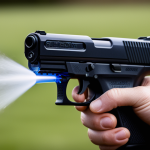Understanding the Importance of Transition Times
Triathlon transition times play a crucial role in race efficiency. They are the periods between the swim, cycle, and run segments where critical seconds can make a significant difference in overall performance.
Triathletes often underestimate the negative impact of poor transition strategy. For instance, wasting time locating gear can lead to unnecessary delays. Moreover, sluggish transitions can disrupt momentum and diminish race efficiency.
Also to see : Unlocking Gymnastic Greatness: The Power of Proprioceptive Training in Boosting Athletic Performance
A well-organized transition strategy can significantly enhance overall performance. This includes:
- Having a pre-planned system for arranging and accessing gear quickly.
- Choosing equipment like elastic laces that allow for swift transitioning.
- Practicing transitions as diligently as one would the main segments of the race.
Common mistakes include fumbling with equipment and losing track of priorities under pressure. By refining the skills needed for transitions, such as efficiently removing a wetsuit or mounting a bike, athletes can gain a competitive edge.
Also read : Unlock Peak Muscle Gains: How Strategic Protein Timing Transforms Your Weightlifting Success
Optimizing transition times not only saves time but also conserves energy for the race segments that follow. Triathletes can improve transition efficiency by developing a personalized transition strategy and incorporating it into their regular training regimen. Emphasizing smooth, systematic changes will undoubtedly boost triathlon success.
Essential Tips for Quick Transitions
Achieving race efficiency in triathlons revolves not only around mastering the swim, bike, and run but also perfecting the transitions in between. Transition areas can become chaotic, yet by implementing quick transition techniques, you can maintain momentum and conserve valuable energy.
Pre-Race Preparation
Setting up an organized transition area is paramount. Ensure your gear is laid out logically, with items positioned for easy access. Practicing the layout routinely helps embed these patterns. Equipment choices, like elastic laces and quick-drying gear, are more than convenient—they’re racing essentials. These tools substantially reduce the time fidgeting with traditional fastenings, promoting a smoother transition.
Transition Techniques
Whether it’s efficiently mounting a bike or swiftly shifting from swimming to cycling, small adjustments have significant impacts. Practice dismounting techniques and maintain a proper running form as you transition to different segments. Implement these techniques during your training to develop muscle memory, crucial under race pressure.
Routine and Habits
Forming a personal transition routine requires repetitive practice. Emphasize the psychological aspect—staying focused and calm is as crucial as physical agility. Mimic race conditions in training, creating drills that enhance not only speed but also composure. Building these habits can greatly affect your overall performance, transforming transitions into a strength rather than a setback.
Training Recommendations for Effective Transitions
Enhancing race efficiency requires targeted training strategies. Incorporating specific drills into your training regimen can substantially improve transition speed. One key drill is practising race simulation. By emulating race conditions, athletes can work on transitioning quickly and smoothly across segments in a controlled environment. This not only helps in identifying potential delays but also aids in adapting to different race distances.
To boost transition performance, speed drills should be a staple in training weeks. These drills focus on hasty equipment changes and efficient movements between disciplines. For instance, practising quick dismounts or rapid attire changes simulates real-race scenarios, getting athletes accustomed to the pressure of saving time.
Furthermore, regular practice of transitions intertwined within your training routine ensures that these skills become second nature. Emphasizing the integration of transitions throughout training sessions prepares athletes for the dynamic nature of competitions. It also assists in personalizing techniques to suit individual strengths and weaknesses.
Finally, tailoring transition training to align with the requirements of various race types—sprint, Olympic, or Ironman—can help athletes refine their strategy, ensuring they are as prepared for short bursts of speed as they are for endurance-heavy transitions.
Insights from Experienced Triathletes
In the triathlon community, gaining valuable expert advice from seasoned athletes can significantly enhance one’s approach to transitions. These athletes’ shared experiences serve as a mentorship channel, revealing tried-and-tested strategies that can streamline transition times.
Success Stories
Triathletes who have refined their transition techniques often share compelling success stories. For instance, one notable athlete managed to cut down their transition time by implementing strategic race simulation. This approach, emphasized by professionals, involves replicating race conditions in training, allowing athletes to familiarize themselves with actual race efficiency scenarios. Key strategies such as setting equipment in precise order and rehearsing the drills numerous times contribute to these achievements.
Common Misconceptions
There are prevalent misconceptions concerning transition inefficiencies, which experienced triathletes often debunk. Contrary to popular belief, maximizing speed does not always sacrifice safety. Seasoned athletes demonstrate that maintaining a focused mindset with a steady pace can effectively blend speed with safety. By fostering these practices, the triathlon community continually evolves towards more efficient races.
Athlete experiences underscore that attentiveness to details and psychological preparedness during transitions play a substantial role in overall performance. Benefiting from community insights, athletes can refine their strategies, prioritizing both safety and speed for optimal transition efficiency.
Visual Aids and Resources
Incorporating visual aids into transition preparation offers an engaging way to streamline race-day processes. Triathletes benefit immensely from transition checklists, which provide a structured approach to organizing gear. Detailed lists help ensure that nothing is overlooked, and every item is in its designated place for optimal race efficiency.
Additionally, visual guides serve as a practical tool for understanding transition setups. Diagrams or infographics depicting the ideal arrangement of equipment can clarify the often-confusing logistics involved in swift gear changes. These resources transform abstract concepts into tangible, actionable steps for organizing one’s transition area effectively.
For those looking to dig deeper, numerous resources exist online offering comprehensive courses and tutorials, including images and videos. These guides not only illustrate proper technique but also showcase tried-and-true transition strategies from seasoned experts, aiding in mastering the essential rhythms of triathlons.
By employing these visual tools, athletes can familiarize themselves with various aspects of successful transitions, from efficient transition techniques to psychological preparedness. Not only do they enhance understanding, but they inspire confidence, encouraging athletes to execute transitions with precision and minimal stress. This visual approach becomes a foundational aspect of a triathlete’s training regimen, promoting continuous improvement and success.


